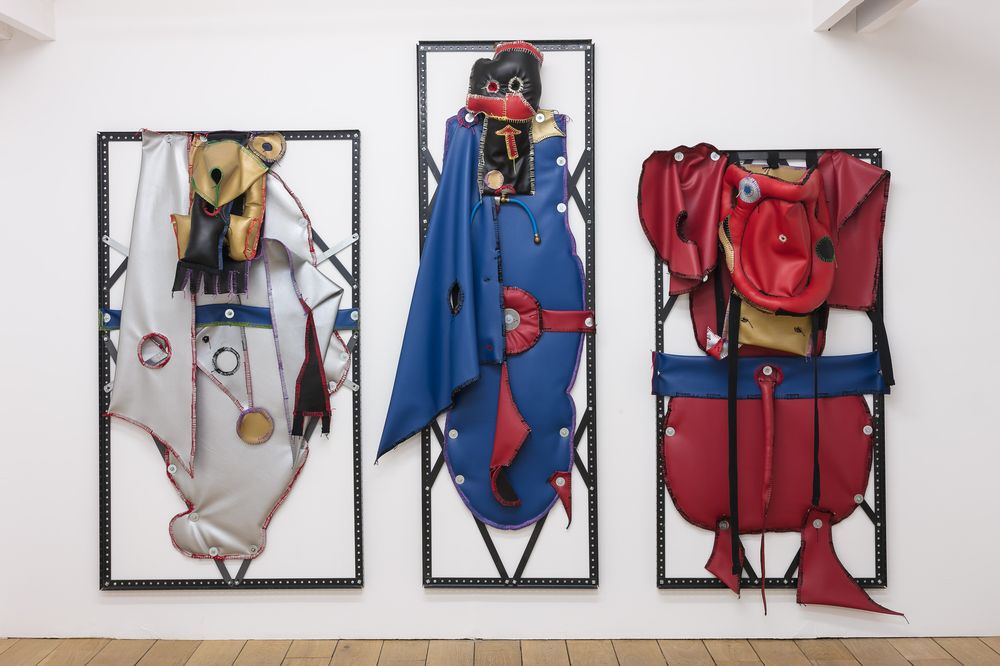Frieze Review: R.M. FISCHER at Southard Reid, London, UK

by Ben Eastham
Children are driven to break their playthings, Charles Baudelaire observed in 'The Philosophy of Toys' (1853), by an overwhelming desire to discover the soul. The failure to find it amidst the toy's dismembered parts heralds 'the beginning of melancholy and gloom'. After this 'first initiation into art,' no later experience will ever recapture the imaginative investment of a child in his toys, nor compensate for the realization that the objects to which he was so emotionally attached were not possessed of a soul.
The recent sculpture of R.M. Fischer assembles scraps of obsolete material into ingenious figurative works that excite something of that lost enthusiasm for inanimate objects. 'Sculpture', the New York-based artist's first solo exhibition at Southard Reid in London, presents a close-knit community of assemblages stitched and bolted together from stuffed vinyl, tangled wire innards, antique lampshades, brightly coloured car upholstery, metal fixtures, wooden pallets and other industrial materials. These jerry-rigged characters perch on shelves, stand on the floor and teeter on windowsills as if they were disturbed during a conference and are now - like the protagonists of Pixar's Toy Story (1995) - compelled to feign insentience.
The first part of Fischer's tripartite career - the middle section of which he spent working on large-scale public art projects across the US, including the vast ornamental light sculptures that spike the downtown Kansas City skyline (Sky Stations, 1991-94)- is characterized by retro-futuristic sculptural assemblages featuring working light bulbs. His early successes are represented here by the art deco-ish Rocker (1980), a hulking 'lampwork' that, by incorporating figurative source material and conflating fine art with commercial design, chimes with the artistic discourse of the early 1980s. But Rocker is less interesting as neo-geo comment on com modification than as an eccentric expression of industrial-age animism. The Henry Moore-ish sweep of its galvanized steel base and points of light - familiar visual metaphor for life - suggest an enchanted machine, bringing to mind David Bowie's reincarnation in the final season of Twin Peaks (2017) as a giant tea kettle.
The artist's later work- everything else in the exhibition dates from the past six years - weds friendlier personalities to cuddlier forms. Perched unsteadily on a high wooden shelf, like marionettes in Gepetto's workshop, the two small sculptures RMF4321 (2014) and RMF4863 (2011) exude a ramshackle, steam-punk charm. The former describes a patchwork face (almost all of the works satisfy the human predisposition to identify facial features in any composition) in sewn pockets of stuffed fabric, the overt imperfection of the stitching arid bright colours rendering cartoonish what might otherwise have seemed uncanny. Thest:l creatures relate to the stuffed animals of Mike Kelley and soft sculptures PY Louise Bourgeois, but where their more sinister work enacts a kind of teddy-bear body horror - all eviscerated entrails and dismembered limbs - Fischer's ragbags speak of repair and rehabilitation.
By using found objects and forms, the composition of the sculptures is guided as much by the formal properties of the materials as any overarching design. RMF9765 (2017) reads like the solution to a particularly tricky DIV problem, its gangling prostheses, light fittings and vinyl fabrics coming together in a collision of forms and textures that feels nonetheless satisfying. Idling in a corner upstairs, the bandy-legged RMF7541 (2015) could be one of the jerry-rigged androids constructed out of spare parts by J.F. Sebastian in Ridley Scott's Blade Runner (1982). The lonely genetic designer saw no contradiction between their status as compassionate subjects and material objects - 'They're my friends. They're toys. My friends are toys. I make them.' -and the longer you spend with Fischer's fetish objects, the more you are inclined to value them on their own terms rather than merely as human surrogates.
A comparison with the anthropomorphic textile sculptures of Tamara Henderson illustrates this point. Where Henderson provides her characters with evocative names (Panting Healer, Scarecrow) and ritualized backstories that emphasize their 'aliveness', Fischer's standardized titles foreground the works' status as manufactured products. Meaningful attachment to these objects should not rely on the infantile delusion that they are equipped with human souls - as children are apt to believe of toys - but on the more mature recognition of our profound entanglement with the nonhuman world of which they are representative parts.
If the symbolic play of childhood is the first introduction to social norms, then the breaking apart of toys is indicative of Western society's more broadly destructive attitude towards the physical environment. By constructing new toys from the detritus of commodity capitalism - and provoking you to empathize with them - Fischer's latest sculptures propose a more humane relationship to the world of things.